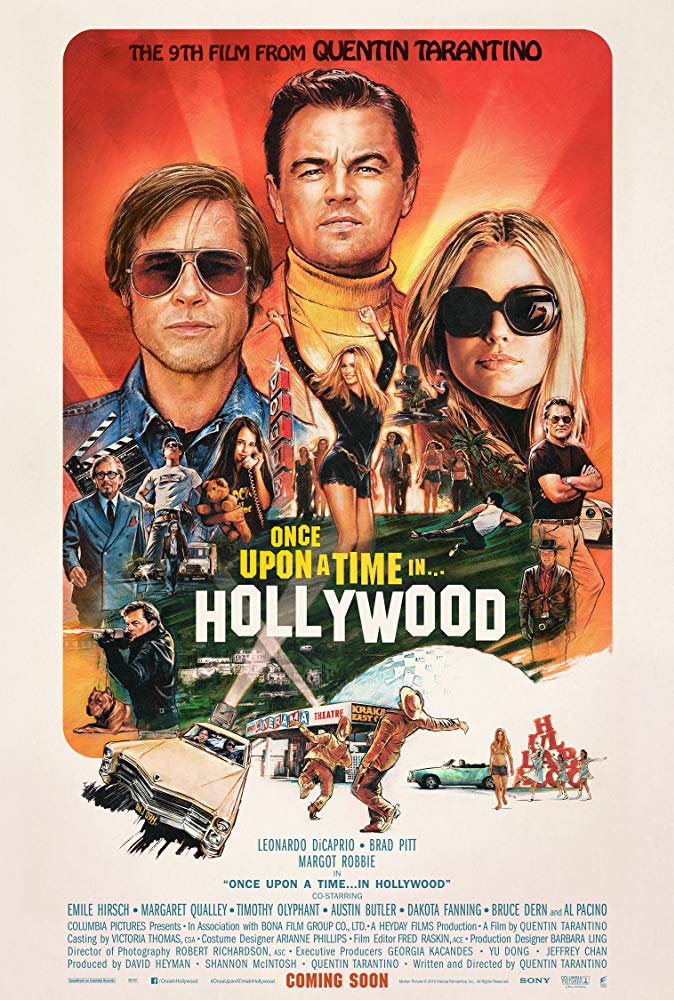Painting a riveting tale of Hollywood in the late 1960s, Tarantino mixes fiction with reality in his latest masterpiece, “Once Upon a Time in Hollywood,” concocting a nostalgic elegy to the golden age of film and TV. Throughout the film, Tarantino references popular culture of the era from vintage cars to cowboys — and tangentially includes the infamous Manson family.”Once Upon a Time in Hollywood” marks Tarantino’s ninth film, and arguably his most tender work. Nonetheless, Tarantino’s signature of unpredictability and controversy still persists. In particular, Tarantino’s depiction of Bruce Lee and his unconventional ending have both sparked great controversy.
The heart of the story revolves around fictional characters Rick Dalton(Leonardo DiCaprio), a fading Western-style actor, and Cliff Booth (Brad Pitt), Rick’s loyal sidekick and stunt double, both of whom yearn for fame and social acceptance. After starring in his ultra-violent cowboy TV show “Bounty Law,” Dalton has become type-cast to merely play the role of the villain on newer TV shows. Booth can no longer find work as stuntman. It is painful to watch Dalton writhe in self-inflicted agony, drowning his sorrows in bottles of alcohol.
However, the manner in which Booth cares for Dalton is heartwarming. Tarantino creates a strong bond between these two characters: their relationship is “more than a brother and a little less than a wife.” The two men do not see their differing levels of social status to be a hindrance to their friendship. Instead, their friendship is based on years of working together and genuine care for one another.
One evening, as Booth drives Dalton up to his house on Cielo Drive, the two run into Sharon Tate (Margot Robbie), a rising starlet, and Roman Polanski (Rafał Zawierucha), a promising movie director known for his hit film “Rosemary’s Baby.” Dalton is in awe of the couple. To him, they represent the allure of modern Hollywood, something he wishes so dearly to be part of. But Tate, like Dalton and Booth, is also hungry for approval.
In order to gauge the audience’s reception to her latest performance in “The Wrecking Crew,” Tate goes into a theater to observe the audience’s facial expressions. This scene is one of my favorites, not just for Robbie’s superb acting skills, but for the manner in which Tarantino portrays this young woman — as someone who has an infectious smile and infinite potential. Tarantino truly humanizes Tate, giving the audience a glimpse into her everyday life as a budding actress in Hollywood.
“Once Upon a Time in Hollywood” is by no means perfect. Tarantino tends to celebrate white male stardom and perpetuate racial slurs, especially with his inappropriate depiction of Bruce Lee. The particular scene with Lee comes in the form of a flashback, featuring sadistic banter between Booth and Lee; a brawl breaks out shortly after. Lee is the only person of color in the film, and Tarantino chooses to depict him as a self-absorbed star. Lee’s daughter Shannon Lee has strong feelings about Tarantino’s depiction of her late father.
“He [Tarantino] could shut up about it . . . or he could say, ‘I don’t really know what Bruce Lee was like. I just wrote it for my movie. But that shouldn’t be taken as how he really was,” Lee told Vanity Fair.
Tarantino does not give Lee the same respect he gives to fictional white characters like Booth and Dalton.
“The racist representation of Bruce Lee felt offensive and poked fun at him,” Ashley Sakata (first year) said. “This depiction evoked racist stereotypes of Asians that people still use today.”
As an Asian American, I felt personally offended by Tarantino’s portrayal of Lee, because he feeds into the notion that it is acceptance to silence the voices of Asians.
“What you have to remember is the time in which this film takes place… I feel like the film… tried to be historically accurate as far as racial and gender [hierarchies],” Zachary Galen (first year) said.
Galen makes a good point; however, I wish Tarantino would have depicted Lee with more dignity, as he was a trailblazer for Asian Americans in film.
After nearly three hours exploring the intriguing lives of Dalton, Booth and Tate,Tarantino decides to shock viewers by altering the course of history. In the late 1960s, the Manson family committed a number of heinous crimes in the Los Angeles area, including the infamous murder of Sharon Tate. Four members of the Manson family — Charles “Tex” Watson, Susan Atkins, Patricia Krenwinkel and Linda Kasabian — invaded Tate’s home, killing five people and stabbing Tate a total of 16 times. The night of August 9, 1969 marked the end of Tate’s life at the hands of the Manson family, and the turning point of the good ol’ days of Hollywood, as paranoia swept over the country. However, Tarantino does not take his film down this tragic reality. Instead, he creates a fairytale ending for Tate — hence the title “Once Upon a Time in Hollywood.” In this alternate-universe ending, the Manson family raids Dalton’s home and never even enters the home of Tate and Polanski. Tarantino’s override of history gives Tate her life back — even if it is just in the cinematic sense — and restores the agency and dignity she lost.

“Everyone who knows Sharon Tate has known her for her murder, so it’s nice in this little day in the life movie to see her as a human being,” professor Sky Anderson of the Media Arts & Culture department said. “She was my favorite part of the movie.”
This film is a heartfelt love letter to the dying age of Old Hollywood, juxtaposed by the birth of a new cinematic age filled with freedom and vibrancy. “Once Upon a Time in Hollywood” is a cinematic work of art, immersing viewers into a whimsical and beautiful world even if it is just for a few hours.
![]()



































